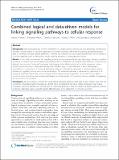| dc.contributor.author | Melas, Ioannis N. | |
| dc.contributor.author | Mitsos, Alexander | |
| dc.contributor.author | Messinis, Dimitris E. | |
| dc.contributor.author | Weiss, Thomas S. | |
| dc.contributor.author | Alexopoulos, Leonidas G. | |
| dc.date.accessioned | 2011-11-07T21:47:03Z | |
| dc.date.available | 2011-11-07T21:47:03Z | |
| dc.date.issued | 2011-07 | |
| dc.date.submitted | 2011-02 | |
| dc.identifier.issn | 1752-0509 | |
| dc.identifier.uri | http://hdl.handle.net/1721.1/66963 | |
| dc.description.abstract | Background
Signalling pathways are the cornerstone on understanding cell function and predicting cell behavior. Recently, logical models of canonical pathways have been optimised with high-throughput phosphoproteomic data to construct cell-type specific pathways. However, less is known on how signalling pathways can be linked to a cellular response such as cell growth, death, cytokine secretion, or transcriptional activity.
Results
In this work, we measure the signalling activity (phosphorylation levels) and phenotypic behavior (cytokine secretion) of normal and cancer hepatocytes treated with a combination of cytokines and inhibitors. Using the two datasets, we construct "extended" pathways that integrate intracellular activity with cellular responses using a hybrid logical/data-driven computational approach. Boolean logic is used whenever a priori knowledge is accessible (i.e., construction of canonical pathways), whereas a data-driven approach is used for linking cellular behavior to signalling activity via non-canonical edges. The extended pathway is subsequently optimised to fit signalling and behavioural data using an Integer Linear Programming formulation. As a result, we are able to construct maps of primary and transformed hepatocytes downstream of 7 receptors that are capable of explaining the secretion of 22 cytokines.
Conclusions
We developed a method for constructing extended pathways that start at the receptor level and via a complex intracellular signalling pathway identify those mechanisms that drive cellular behaviour. Our results constitute a proof-of-principle for construction of "extended pathways" that are capable of linking pathway activity to diverse responses such as growth, death, differentiation, gene expression, or cytokine secretion. | en_US |
| dc.description.sponsorship | Marie Curie International Reintegration Grants (MIRG-14-CT-2007-046531) | en_US |
| dc.description.sponsorship | Vertex Pharmaceuticals Incorporated | en_US |
| dc.description.sponsorship | Bundesministerium für Wissenschaft und Forschung (HepatoSys) | en_US |
| dc.description.sponsorship | Massachusetts Institute of Technology (Rockwell International Career Development Professorship) | en_US |
| dc.description.sponsorship | Bundesministerium für Wissenschaft und Forschung (HepatoSys 0313081D) | en_US |
| dc.language.iso | en_US | |
| dc.publisher | BioMed Central Ltd. | en_US |
| dc.relation.isversionof | http://dx.doi.org/10.1186/1752-0509-5-107 | en_US |
| dc.rights | Creative Commons Attribution | en_US |
| dc.rights.uri | http://creativecommons.org/licenses/by/2.0/ | en_US |
| dc.source | BMC | en_US |
| dc.title | Combined logical and data-driven models for linking signalling pathways to cellular response | en_US |
| dc.type | Article | en_US |
| dc.identifier.citation | Melas, Ioannis N et al. “Combined logical and data-driven models for linking signalling pathways to cellular response.” BMC Systems Biology 5 (2011): 107. | en_US |
| dc.contributor.department | Massachusetts Institute of Technology. Department of Mechanical Engineering | en_US |
| dc.contributor.approver | Mitsos, Alexander | |
| dc.contributor.mitauthor | Mitsos, Alexander | |
| dc.contributor.mitauthor | Alexopoulos, Leonidas G. | |
| dc.relation.journal | BMC Systems Biology | en_US |
| dc.eprint.version | Final published version | en_US |
| dc.type.uri | http://purl.org/eprint/type/JournalArticle | en_US |
| eprint.status | http://purl.org/eprint/status/PeerReviewed | en_US |
| dspace.orderedauthors | Melas, Ioannis N; Mitsos, Alexander; Messinis, Dimitris E; Weiss, Thomas S; Alexopoulos, Leonidas G | en |
| mit.license | PUBLISHER_CC | en_US |
| mit.metadata.status | Complete | |
